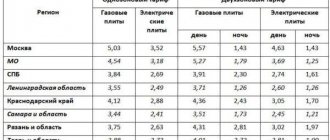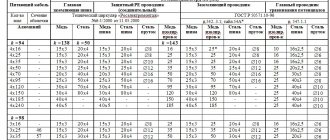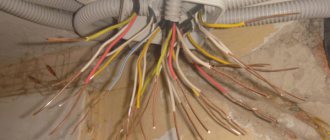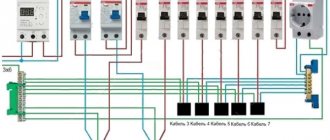When arranging the environment in an individual building, it is difficult to foresee everything at once. After some time, there is a need to increase the electrical load per residential building user. Country home owners experience this problem more often than others.
Any country house needs power in kW Source pokter.ru
How can you increase the permitted kW power of electricity? For a private home, solving the problem of increasing load is quite possible. It will be possible to increase the permitted power of electricity consumed by the owner of a country house if certain conditions are met.
Increasing electricity capacity for private homes
There are 3 options, you can choose one of the following solutions:
- Send an application to the network company.
It sets out a request for additional electricity.
- Formally, “increase” the power consumption.
This can be done through proper load distribution. This will require prioritization skills.
- Install an inverter in the house.
This is special storage type equipment.
Storage type equipment for a private home Source topradar.ru
How to calculate the electrical power of a residential building?
First you must decide which boiler you will have, electric or gas. If the boiler is electric, then this should be taken into account.
In general, we take a piece of paper and begin to write down all the electrical appliances that you plan to equip your home with.
We must not forget anything!
- How many light bulbs will there be in the house? Which ones?
- TV?
- Computer?
- Fridge?
- Microwave?
- Washing machine?
- Boiler (if electric)?
- Iron?
- Electric kettle?
- Aquarium? What do you think... It also consumes electricity.
- What kind of stove will you have? Electric or gas, or maybe induction?
- Will you have a dishwasher? Not now? And then?
Have you forgotten anything?
- And the Karcher in the garage?
- Maybe a heater?
- And the lamps in the garage?
Well, that seems to be it.
Sure?
Will you install a bathhouse? What are you planning to use there? What electrical appliances? How will you get water into it? By any chance, is it a pump with an electric motor?
In general, I think I clearly explained that when calculating the electrical power of a private house, nothing should be neglected.
Buildings for which the electrical load can be increased
The need to increase electric power capacity may arise for various reasons. More often than others, applications are submitted for such objects as:
- private houses;
- cottages;
- garages;
- residential or non-residential premises in suburban buildings.
In an apartment building, increasing the permissible load for a specific apartment is an almost impossible task. How to increase electricity capacity for the owner of such a home? Let's look at it in this article.
Increasing the electrical load of your home
First, the total load of all electrical appliances used in everyday life is established, that is, add up their calculated capacities. Coefficients are applied to the resulting value and an indicator of the total power consumption is obtained.
Electrical installation work cannot be carried out without first obtaining permits. Any actions with the electrical panel must be coordinated in advance with the relevant structures that supply users with electricity.
How to increase electricity power in a private home? Read in the next section.
What it is
During capital construction during the USSR, for example in Khrushchev buildings, i.e. In most residential premises that are still in use today, even at the design stage the permitted power was up to 1.5 kW per apartment.
Later, the established electricity rate increased to 3 kW, as it became necessary to increase it due to the increased “gluttony” of consumers. Practice shows that 10-16 Ampere plugs were usually installed in electrical panels and meters, so that the maximum current consumed by an apartment was limited to a total electrical power of 3 kW for apartments with a gas stove. For apartments where an electric stove is installed, 7 kW is allocated. In new buildings, the allocated power can reach up to 15 kW. This scatter is due to the fact that during the construction of old houses (60s, 70s) there simply were not such powerful consumers and as many household appliances as there are now.
The allocated power is the maximum amount of electricity consumed at one point in time.
In addition, in order to enter the established limit, sometimes you need to enter not just 1 phase, as often happens, but as many as 3 phases. This is necessary for connecting modern household appliances, such as powerful electric boilers and electric stoves. This is especially true in commercial premises and industries of any scale, where a lot of electricity is needed (up to 30 kW and above).
Example. To heat a country house that is not equipped with gas equipment, solid fuel and electric boilers are installed, the latter are safer and more convenient. For heating a house with an area of 100 sq.m. you need a boiler with a power of about 7-10 kW, an electric stove consumes another 3-5 kW. In total, it is necessary to increase the established electricity limit to a minimum of 15 kW and supply electricity in three phases.
To find out the allocated power for a private house or apartment, you need to contact the operating organization (in Moscow and the region - this is Mosenergosbyt OJSC). The help contains information about the allocated and average power consumption. It will be needed if you are preparing documents for an increase; this will be discussed in detail below.
Stages of the procedure
To obtain permits you must:
- Write a statement to the local Electric Networks.
Increasing the kW power to 15 kilowatts for electricity consumption will require obtaining technical conditions for connecting an additional load and other permitting documents.
- Take a technological connection agreement.
In response to the submitted application, the network organization issues electrical documentation: technical specifications (technical conditions), permission to connect additional power to supply the house with electricity. These documents are calculated by specialists from the electric grid company. The applicant is also given a draft agreement for technical connection to the networks; it is signed by both parties after familiarization.
It is important to know! Do not confuse the two agreements: 1) for connection; 2) for power supply. The latter is issued to the applicant at Energosbyt after successful completion of all procedures for increasing power. As evidence of completion of the process, an act will be drawn up, which will become a permitting document (approval of the electric meter for operation).
- Contact a company that develops project documentation.
The property owner needs to review the current documents relating to the electricity supply of his property. All changes provided for in the technical specifications must be completed. But first they must be reflected in the design documentation.
Electrical supply project for a private house Source ehto.ru
- Perform electrical installation work.
It all depends on the requirements specified in the technical specifications. Technological connection, when increasing the permitted power, can be made by both representatives of electrical networks and a specialized electrical installation organization that has SRO approvals.
Based on the results of the work performed, 3 acts are prepared:
- compliance with technical conditions;
- approval of the electric meter for operation;
- on the implementation of technological connection.
It is very difficult and almost impossible for the property owner to deal with these issues independently. For this, many home owners turn to specialized organizations.
- Submit documents to the energy sales company.
Based on 3 acts, energy sales representatives will make adjustments to the electricity supply agreement.
What are the dangers of exceeding the permitted power?
Currently, when it detects that the maximum load has been exceeded, the electric company introduces a consumption limitation mode. The basis for this is a violation of the obligations specified in the energy supply agreement. As a rule, limiting consumption is turning off the electric current. The algorithm for sending such a notification is shown in the figure.
Example of a consumer notice
After 10 days after sending the notice, the company disconnects the power supply. To avoid this, the consumer must eliminate the violation within ten days, and then contact the service provider to draw up the appropriate report. Electricity supply will be restored after the electric company pays the penalty in accordance with the contract.
More serious consequences may arise if, in addition to violating the amount of allocated energy, an accusation of uncontrolled electricity consumption is brought forward. The basis for this will be the removal of seals from the input machine. You can get more detailed information about the consequences of uncontrolled electricity consumption, electricity metering rules, etc. on our website.
Seal on the introductory machine (marked in red)
Increasing electricity capacity in a private home: when additional demand arises
Cases where there is not enough allocated power occur after:
- repairs associated with redevelopment;
- installation of a “warm floor” connected to electricity;
- expansion of housing area;
- simultaneous use of household appliances.
The most powerful devices:
- electric stove oven;
- washing machine and dishwasher;
- air conditioner;
- TV;
- microwave.
If all devices operate simultaneously, the allocated kW power may not be enough.
When the allocated power is not enough
The standard power that is allocated to the individual housing construction site in the Moscow region is 15 kW in 3 phases (input circuit breaker for 25 A). This is quite enough for a normal life in a medium-sized house using all the benefits of civilization.
However, the administration of some villages forcibly limits the maximum power consumption to a minimum. This is done for two reasons:
- there is not enough power of the power transformer for all areas (often in SNT)
- a separate and often very high fee is charged for the allocation of additional power (typical for plots with a contract in expensive cottage villages). We heard figures of 1 million rubles for the transition from a three-phase 10A to 25A circuit breaker.
In practice, we have encountered the following cases:
- single-phase connection, 16A automatic at the input (3.5 kW for the whole house). Turning on the kettle while the oven or washing machine is running leads to knocking out the input machine
- with a three-phase connection and a 10A circuit breaker - this is 2.2 kW for each phase, i.e. only 6.6 kW. If two powerful devices fall on the same phase, the machine is triggered and the whole house is plunged into darkness. It is practically impossible to distribute the load across phases.
- Three-phase connection for 16A - 3.5 kW per phase.
Below is a photo of a street accounting cabinet that we took in one of the villages near Moscow:
Outdoor accounting cabinet for several houses
As you can see, the standard power for a cottage with an area of 250 square meters is 6.6 kW (ABB SH203 C10 automatic machine). For an additional cost you can purchase C16 (10.5 kW) or C25 (15 kW).
Modular automation based on priority relays
We highlight priorities and collect machines into 2 groups – switchable and non-switchable. Disabled items include:
- Electric boiler
- Electric underfloor heating and other heating/heating
- Electric boiler
- Thermopot, etc.
- Powerful non-priority lighting, etc.
Increasing electrical power in non-residential premises
Typically, commercial real estate operates devices that consume a lot of electricity:
- refrigeration units in production shops;
- air conditioners in offices;
- freezers in retail chains.
Because of this, owners of commercial properties are forced to deal with issues of increasing the permitted load in order to avoid interruptions in the power supply to the facility.
How to increase electricity power in non-residential premises?
The process consists of 4 stages:
Step 1. First, an application is submitted to the power grid organization, drawn up according to a standard template. Attached to it:
- a scan of the lease agreement or certificate of ownership of the property (information from the Unified State Register of Real Estate);
Sample USRN extract for a real estate property Source prodom365.ru
- extracts from the register of the Federal Tax Service for legal entities or individual entrepreneurs;
- scan of the organization's Charter;
- a duplicate of the order for the appointment of a director of the enterprise;
- power of attorney for the owner's representative.
Step 2. Obtaining technical conditions and a connection agreement.
The technical specifications indicate a list of electrical installation work required to be performed by the applicant, as well as by the electrical grid organization.
Step 3. Carrying out the activities provided for by Electric Grids.
The applicant carries out electrical installation work indoors at his own expense. The remaining procedures are carried out by the network company. After completion of the required work, on-site inspections are carried out by representatives of electrical networks. If there are no violations, reports are issued.
Step.4 All changes made to the power plan are included in the current contract.
Within a month after completion of the work and if there are 3 acts, the applicant enters into the contract with the energy supply organization information about increasing the permitted power.
How to increase power in an apartment
The situation is completely different with an increase in power per residential apartment. According to current legislation, a corresponding application to increase the capacity of a private apartment must be submitted by the organization that manages the multi-apartment residential building in which the apartment is located. Accordingly, the registration of increasing the power of the apartment occurs according to the following algorithm:
- submission by the management company of an application to increase the power of the entire residential building to the network organization;
- receipt by the management company of a technological connection agreement and technical conditions;
- carry out the necessary measures in accordance with the issued technical specifications;
- inspection of the electrical installation of a residential building by a representative of the network organization for its compliance with current technical specifications and current standards and regulations;
- obtaining documents on increasing the capacity of a residential building;
- preparation of documents with the management company on the allocation of additional power to the apartment, at the expense of the power of the residential building;
- making changes to the personal subscriber account at an energy sales organization.
Documents for increasing the load on an existing facility
Documents for increasing the load on an existing facility
The list of documentation for increasing the electrical load is exactly the same as for a new connection to the electrical grid.
For legal entities, the following must be attached to the application:
- layout of equipment and lighting fixtures;
- scan of the certificate of ownership of the object;
- extract from the Unified State Register of Legal Entities;
- a copy of the charter and constituent documents.
When a third party is entrusted to represent the applicant’s interests, a notarized power of attorney is attached.
Applications of ordinary citizens are supplemented with the following data as defined in the Decree of the Government of the Russian Federation:
- scanned copy of the certificate of ownership (USRN extract);
- copy of the passport;
- layout plan for electrical appliances;
- notification of the absence of emergency automatic devices.
It is important to know! For commercial premises located in a residential building, you must obtain consent from the management company.
What cannot be placed in an apartment building? Source trishurupa.ru
What is needed to increase electricity power in an apartment
Sometimes property owners in an apartment building need to increase the permitted power. Usually this situation appears after installation:
- heated floors connected to electricity;
- air conditioners;
- electric stoves
In a normal situation, one apartment does not consume more than 15 kW of electricity. It is difficult to obtain high permissible power for housing located in an apartment building. It is impossible to provide an electrical load to a specific apartment owner. The legal entity that is the balance holder of the internal electrical network of the entire house must request additional power.
Increasing the permitted power in a parking garage
For this purpose, you need to contact the local Electric Networks with an application. List of required documents:
- scanned copy of the certificate of ownership (USRN extract);
- copy of the owner's passport;
- architectural plan showing the location of the garage;
- scan of the TIN certificate.
Based on the received application, the network organization issues specifications to the applicant that are subject to execution. All work within the garage provided for by the technical conditions is carried out by the owner on his own. Upon completion of all necessary actions, an employee of the electrical network company inspects the metering device. The correspondence of the counter with the specifications and the PUE is established. If there are no violations, 3 acts described earlier are issued. Based on permitting documents, the energy supply company increases the estimated capacity for the garage.
Any garage needs electricity Source russtroys.ru
Receiving and increasing the allocated load up to 15 kW
An applicant who submits an application to connect an authorized power of up to 15 kW, taking into account the already connected load, pays for electrical installation work at a reduced price of 550 rubles including VAT.
The cost of 1 kW is influenced by the following factors:
- the magnitude of the declared load;
- location of the object connected to the network;
- technical resources for accession;
- power supply category.
An application for the issuance of technical specifications for increasing the permitted power to 15 kW at a preferential tariff for previously constructed buildings must be submitted only if it is not possible to prove your right to an additional electrical load.











